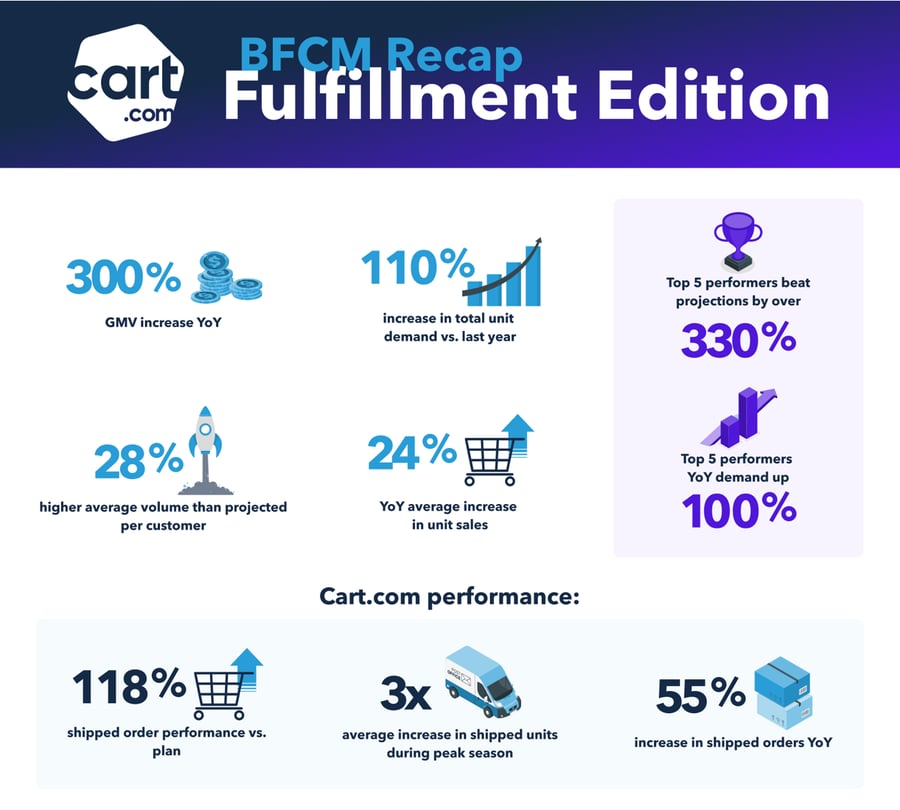For most ecommerce businesses, Black Friday through Cyber Monday (BFCM) is the year’s pinnacle. As part of peak season – the period between November 20th and December 1st – BFCM is a time of high shopper turnout that typically equals a high influx of sales for retailers.
This year, the 5-day Thanksgiving Day through Cyber Monday shopping weekend saw a record-setting turnout of 200.4 million shoppers, including 134.2 million online shoppers.
BFCM is a critical period for ecommerce businesses. Not only is it an opportunity to boost sales and attract new customers, but it’s also a way to build awareness around new products, move inventory and reward loyal shoppers. For many ecommerce businesses, the holidays are a time to drive revenue and profitability, especially given the impact discounts have on consumer demand. This year, online sales for Cyber Week reached $12.4 billion, up 9.6% year over year.
The customer experience is essential to consumer satisfaction. And one primary component of that experience is fulfillment. This includes meeting peak season demand and shipping promises. Today’s customers expect quick shipping and order accuracy, meaning your 3PL plays a significant role in your success.
Peak season 3PL challenges
Ecommerce retailers face several issues throughout BFCM without the right 3PL relationship. Your provider should be able to bolster your efforts to optimize inventory and capacity and streamline your customer service processes during demand spikes, allowing for better customer support.
Shipping logistics also plays a central role in meeting customer expectations. However, package delivery can be affected by unpredictable challenges like adverse weather, or more predictable issues like slower last-mile deliveries due to the surge in package volume.
If your 3PL lacks accurate real-time visibility, you may run into situations where you don’t have a product, even if your site says you do. Your 3PL service should be able to help you keep your promises. For example, delivering within the expected time window – or allowing you to update your customers if you can’t and let them know why.
Cart.com brand performance, BFCM
By the numbers:

During BFCM, Cart.com saw a 118% increase in shipped order performance versus planned and a 3x increase in shipped units during peak season. Year-over-year, there was a 55% increase in shipping orders. When looking at Cart.com’s numbers along with BFCM statistics from the National Retail Federation, it’s clear that this year was a big one for ecommerce retailers. And Cart.com’s customers saw it in action.
Across the board, there was a 300% Gross Merchandise Value increase (GMV) year over year. Customers also experienced a 110% increase in total unit demand versus last year, resulting in a 24% year-over-year average increase in unit sales. On average, there was 28% higher volume than projected per customer.
Cart.com’s top 5 BFCM performers
To put things in perspective, Cart.com customers averaged a 92% increase in shipped units during peak season versus non-peak. The top five performers beat projections by 330%, doubling year-over-year demand. Although forecasts were exceeded, Cart.com flexed up and shipped 18% more than our capacity plan, accommodating our customers’ BFCM performances.
Janie and Jack

Carlene Dyer, Director of 3PL Solutions and Outbound Logistics at Janie and Jack, said, “The Cart team did a fantastic job this year handling the BFCM volume for Janie and Jack – the DC exceeding the daily planned capacity by 7% from Black Friday to December 3rd – AMAZING performance!” She said, “Cart.com’s executive leadership team was present at the facility providing support to the team and committed to making this our best peak season ever. And yes, they did accomplish that goal.”
Tea Collection

Amberly Smith, Customer Support Lead at Tea Collection, said, “This Black Friday and Cyber Monday events went extremely smoothly. In years past, we’ve had a delayed fulfillment SLA as the warehouse strove to keep up with our volume. This year, even as we positively exceeded our sales expectations and forecast, Cart.com rose to the occasion and was able to staff up and fulfill orders on time.”
Last year, Tea Collection had a prolonged time in triage, which extended their shipping tail several days. This year, they addressed issues quickly, keeping their SLA tight and positive and gave priority to aging orders with a focus of FIFO (first in, first out). Smith said,”Cart.com proactively replenished our active locations for quicker fulfillment, they switched out our packaging with an eye on saving us time and money. They prioritized rush orders, so we met our commitments with other partners.”
What’s next?
Inventory replenishment and returns management
The excitement over a strong BFCM can swiftly dissipate when facing inventory replenishment and returns. By implementing straightforward strategies, you can make these tasks more efficient.
Inventory replenishment
The hope is that you’ve moved ample stock during BFCM. If you need to replenish, utilize inventory forecasting. In other words, plan ahead while considering factors like lead time and previous sales data to project future demand. You can use several approaches:
-
Project the economic order quantity using the EOQ formula: The square root (√) of 2x (annual demand in units, multiplied by order cost per purchase order), divided by annual holding cost per unit.
-
ABC analysis: Guide inventory replenishment by determining which products need the most safety stock and highest reorder points. They’ll fall into categories: (A) top sellers or signature products, (B) important but not critical products, and (C) minor products that don’t sell well but are needed.
-
Use passive or active demand forecasting: Passive demand is taking sales dates from past years and projecting them into the future. Active demand considers your past data along with projected growth in your market and projected sales from future marketing campaigns.
Managing returns
Return shipping is another part of the retail process. It’s not a maybe but a given. Although you’ll have plenty of happy customers, things happen – and all the planning in the world can’t prevent returns. To minimize friction:
-
Be fully transparent with your return policy: Make it easily accessible, frictionless and communicative.
-
Give customers a variety of return options: If you have the ability, consider options like dropping at a shipping center (i.e. FedEx, UPS), returning in-person or allowing exchanges.
-
Optimize packaging procedures and shipping: You can prevent returns by handling packaging and shipping optimization better. While this year is over, consider an audit of this year’s damaged packages and what will better secure your product next BFCM.
Planning for BFCM 2024
Your 3PL – along with your peak season strategies – is a large part of your BFCM success. Start early to review your strategies, determine your goals and identify what to measure. Think about the common fulfillment challenges ecommerce retailers face and look for ways to minimize them. Your success depends on having a well-thought-out plan.
Subscribe to our emails for the latest industry insights!
By entering your email, you agree to receive marketing emails from Cart.com






